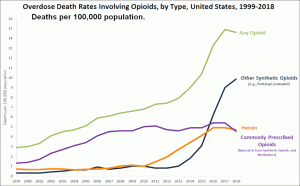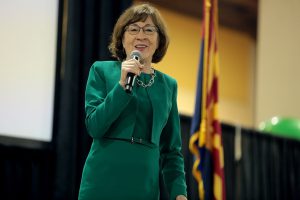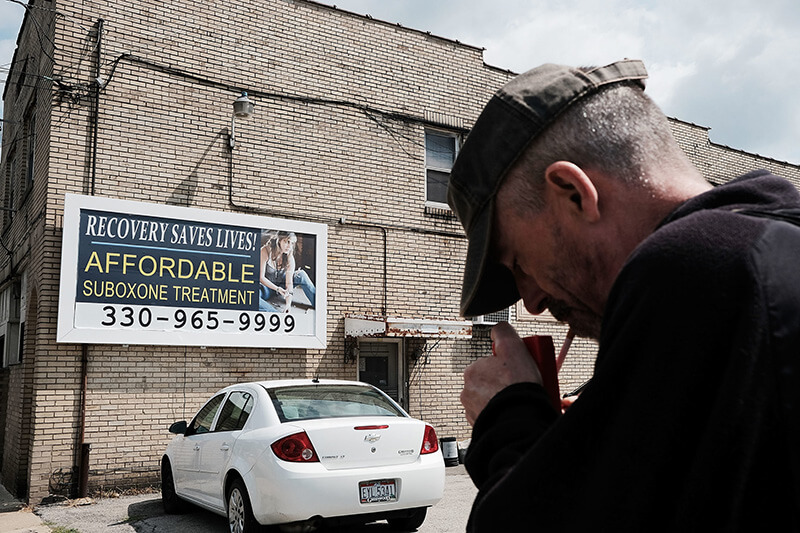In 2020, 377,883 Americans died due to complications from Covid-19, victims of a pandemic that has claimed more than four million lives worldwide.
Like everywhere else, the pandemic has created a generational stress test for the American medical industry, thrusting a new wave of physicians, residents, and med students into the deep end of a long, continuing challenge.
We have seen the world’s health care services given a massive shake along with its medical education pipeline. We have watched a vaccine moon shot touchdown less than two years after the virus first did. We have found how much doctors have been willing to give but, perhaps more importantly, can take.
The long-term benefits and drawbacks will play out over decades. A parallel public health crisis has shown a trajectory that medical education will want to avoid following.
With 115 Americans dying each day from opioid overdoses, evidence-based treatment for opioid addiction needs to be a standard medical competency, not an optional supplement.
More than 93,000 Americans lost their lives to drug overdoses last year, nearly a quarter of the overall Covid-19 number. The most significant portion of the deaths—69,710—came from using synthetic opioids.
Since the beginning of the United States’ opioid epidemic in the late 1990s, new physicians have struggled to deal with addicted patients armed with a shocking lack of training, tools, and support. They share little of the blame.
Outside psychiatry specialization, most medical school programs had devoted mere ‘hours’ to its teaching until recently. A historical lack of addiction medicine fellowships and national umbrella organizations has restricted research and understanding. Until recently, many physicians were kept away from a full range of potential treatment options.
The results aren’t surprising. One 2008 study showed that around 50% of addicted patients surveyed felt their primary care physician “did not address their substance abuse.” A further 40% felt their physician missed the diagnosis of their problem completely.
Recent years have seen genuinely encouraging momentum towards improving the jarring reality the numbers bring. Increasing numbers of med schools are finding expanded space for teaching addiction, fellowship numbers are growing, and a bipartisan mission to inject more resources into addiction medicine is gaining steam in Washington DC.
How far those changes go will determine what treating addicted patients will look and feel like for the next generation of American doctors.
“… the current state of rampant abuse and consequential fatal overdoses afflicting the USA is unacceptable and deserving of a profound response,” the authors of a brief history of American opioid addiction wrote in 2018.
“There is a clear need to end the focus on blaming responsible parties and shift to implementing solutions.”
From ripple to wave
While America’s opioid epidemic is recognized by most as beginning in the late 1990s, its roots lay a decade before.
According to Nature, the 1980s saw a move towards recognizing patient pain as a problem requiring treatment. States passed a series of pain treatment acts that removed potential prosecution of physicians who “treated their patients’ pain aggressively with controlled substances.”

In the 1980s, opioid prescription concentrated primarily on short-term solutions for patients recovering from surgery or suffering from terminal illnesses. Despite early warnings, most thought the likelihood of addiction from opioid treatment unlikely.
Opioid prescriptions “increased gradually” into the 1990s, before giant pharmaceutical companies like Purdue Pharma developed their more potent semi-synthetic drugs. Celebrated as a “wonder drug,” its use was heavily promoted its use amongst doctors, politicians, professional organizations, and med schools.
A pill of pure oxycodone, Purdue Pharma’s Oxycontin, started being prescribed often to those suffering from varying degrees of pain. Addiction would usually follow. “In terms of narcotic firepower,” author Barry Meier wrote in ‘Pain Killer,’ “Oxycontin was a nuclear weapon.”
While producers would eventually admit to the addictive nature of the drugs and later be punished for their usage, the damage was already done. Viewed nearly a quarter of a century after the beginning of the opioid epidemic, it is easy to see why American medicine was utterly unprepared for its impact.
Training in medical addiction was virtually non-existent in the late 90s. Changes have been slow since. In 2018, the New York Times reported it has “[ranged] from one pharmacology lecture to several weeks during a third-year clinical rotation, usually in psychiatry or family medicine.”
The Times also reported that only 15 of 180 American medical programs teach addiction. The first addiction medicine fellowships weren’t launched until 2011.
… the current state of rampant abuse and consequential fatal overdoses afflicting the USA is unacceptable and deserving of a profound response. There is a clear need to end the focus on blaming responsible parties and shift to implementing solutions.
“Medical faculties have traditionally eschewed teaching the subject,” NPR reported, in 2016, “in part because many physicians viewed addiction as a personal vice rather than a disease.
“And, even now, some doctors who specialize in addiction treatment are skeptical that the best care for the problem comes out of a medical model.”
A nationwide survey conducted by the National Center on Addiction and Substance Abuse at Columbia University in 2008 revealed what that meant for patients.
Of the 510 addicted subjects spoken to, more than half said, “their primary care physician did not address their substance abuse.” A further 40% felt their physician missed the diagnosis of their problem completely.
The survey was also conducted on 648 physicians. Less than one in five said they felt “very prepared to identify alcohol or drug dependence.” The same group reported 80% comfortability in diagnosing hypertension or diabetes.
Implementing solutions
Change is starting to happen. Stanford University School of Medicine has been amongst the institutions to first fully incorporate it into their program, treating it as an important part of their students learning.
“We have got an enormous gap between the need and the doctors available to provide that treatment,” Dr. Anna Lembke, the medical director of addiction medicine at Stanford, told NPR in 2019.
“At least the medical community has begun to wake up to consider not only their role in triggering this opioid epidemic but also the ways they need to step up to solve the problem.”
After seeing very little interest from students in addiction medicine for years, program directors have seen a noticeable uptick in interest in it. Lembke says increased student enthusiasm in social justice has played its part.

Only a decade after the first addiction medicine fellowships were established, the number available has grown from 52 to 83 since 2018. It is thought that at least 125 are needed to meet the epidemic’s pressing need.
In 2017, the Accreditation Council for Graduate Medical Education (ACGME) began considering board certification status for addiction medicine fellowships. The first dozen received theirs the following year.
Originally the American Board of Addiction Medicine Foundation, the American College of Academic Addiction Medicine (ACAMA) was established in 2019 as the discipline’s main certification body. It has steadily grown in reach and resources, since.
Lawmakers are finally picking up the baton of addiction medicine, too. In a rare piece of significant bipartisan legislation during President Donald Trump’s administration, Congress devoted $8.5 billion to opioid addiction treatment in 2018.
Recently introduced legislation by Senator Susan Collins, a Republican from Maine, and Senator Michael Bennet, a Democrat from Colorado, seeks to introduce addiction medicine as a permanent part of American medical education.
Earlier this year, Health and Human Services (HHS) eliminated a range of ‘X-waiver’ requirements to allow registered physicians access to buprenorphine, a promising methadone-like opioid addiction treatment. Studying the long-term results of using buprenorphine will surely already be drawing attention amongst the addiction medicine’s growing fellowship community, of course.
“We are in a culture shift; addiction treatment has not historically been part of primary care practice,” Dr. Pamela Pentin, a family doctor at Settle’s University of Washington Medical Center, told MedPageToday in 2019.
“Like with any culture change, we see greater gains in new generations of physicians. Normalizing this in the training phase stands to produce more willing and capable primary care doctors.”
‘… the defining public health crisis of our time.’
With the highly contagious Delta variant widespread, the U.S. is currently in the grip of the fourth big wave of Covid-19 infections since the pandemic began. Unvaccinated Americans are amongst the majority of its current death toll.
As it has with every other element of life over the last 18 months, Covid-19 has made its presence felt in the opioid epidemic. Last week, the Centers for Disease Control and Prevention (CDC) officials told NPR that 2020’s 30% increase in opioid deaths was driven by “the lethal prevalence of fentanyl,” along with the pandemic’s mental health toll, and struggles to find effective addiction treatment.
Delta variant infections have soared in the likes of Missouri, Louisiana, and Florida; states equally hard hit by opioid addiction.
“This has been an incredibly uncertain and stressful time for many people, and we are seeing an increase in drug consumption, difficulty in accessing lifesaving treatments for substance use disorders and a tragic rise in overdose deaths,” Dr. Nora Volkow, head of the National Institute on Drug Abuse, told NPR.
We are in a culture shift; addiction treatment has not historically been part of primary care practice. Like with any culture change, we see greater gains in new generations of physicians.
The 2021 figures for both Covid-19 and synthetic opioid overdose deaths will almost certainly eclipse this year’s figures.
While the long-term likelihood of addressing both is encouraging, the role of addiction in medicine remains a difficult one for newly minted physicians, if not so the students still to join them. Plenty of work remains.
“With 115 Americans dying each day from opioid overdoses, evidence-based treatment for opioid addiction needs to be a standard medical competency, not an optional supplement,” Silva Sundram, a four-year Harvard med student, wrote for the American Medical Student Association in 2018.
“How can we make sure that our generation of physicians is prepared to address the defining public health crisis of our time?”
Main image photo credit: Photo by Spencer Platt/Getty Images



